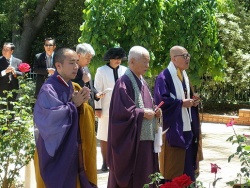Difference between revisions of "Sanne"
| Line 9: | Line 9: | ||
Three different [[robes]] used by [[Buddhist]] {{Wiki|priests}}. According to {{Wiki|Indian}} [[Buddhist]] [[tradition]], each [[monk]] or [[priest]] was allowed [[three robes]], | Three different [[robes]] used by [[Buddhist]] {{Wiki|priests}}. According to {{Wiki|Indian}} [[Buddhist]] [[tradition]], each [[monk]] or [[priest]] was allowed [[three robes]], | ||
| − | These are known as [sougyari]] [[僧伽梨]] (Sk; [[sanghati]]), [[uttarasou]] [[鬱多羅僧]] (Sk; [[uttarasanga]]) and *[[andae]] [[安陀衣]] (Sk; [[antarvasaka]]). | + | These are known as [[sougyari]] [[僧伽梨]] (Sk; [[sanghati]]), [[uttarasou]] [[鬱多羅僧]] (Sk; [[uttarasanga]]) and *[[andae]] [[安陀衣]] (Sk; [[antarvasaka]]). |
The [[three robes]] are different in size and usage: the [[andae]] is the smallest, made from 5 strips of cloth sewn together; | The [[three robes]] are different in size and usage: the [[andae]] is the smallest, made from 5 strips of cloth sewn together; | ||
| Line 15: | Line 15: | ||
the middlesized [[uttarasou]] is made from 7 strips of cloth; and the [[sougyari]] is the largest, made from 9-25 stripes. | the middlesized [[uttarasou]] is made from 7 strips of cloth; and the [[sougyari]] is the largest, made from 9-25 stripes. | ||
| − | (See *[[kesa]][[ 袈裟]]). | + | (See *[[kesa]] [[袈裟]]). |
The [[andae]] is use for work and [[sleeping]], the [[uttarasou]] ([[joue]] [[上衣]]) is used for {{Wiki|worship}}, and the [[sougyari]] (*[[daie]] [[大衣]]) is worn for excursions outside the [[temple]]. | The [[andae]] is use for work and [[sleeping]], the [[uttarasou]] ([[joue]] [[上衣]]) is used for {{Wiki|worship}}, and the [[sougyari]] (*[[daie]] [[大衣]]) is worn for excursions outside the [[temple]]. | ||
Latest revision as of 07:18, 26 February 2016
Also read san'e.
Three different robes used by Buddhist priests. According to Indian Buddhist tradition, each monk or priest was allowed three robes,
These are known as sougyari 僧伽梨 (Sk; sanghati), uttarasou 鬱多羅僧 (Sk; uttarasanga) and *andae 安陀衣 (Sk; antarvasaka).
The three robes are different in size and usage: the andae is the smallest, made from 5 strips of cloth sewn together;
the middlesized uttarasou is made from 7 strips of cloth; and the sougyari is the largest, made from 9-25 stripes.
(See *kesa 袈裟).
The andae is use for work and sleeping, the uttarasou (joue 上衣) is used for worship, and the sougyari (*daie 大衣) is worn for excursions outside the temple.
However, the andae is occasionally defined as a garment used to clothe the lower-body from the hips down *kun 裙; the uttarasou as a garment for the upper body; and the sougyari and additional garment used in cold weather.
There are specific references to the clothing of religious men, special mention being made of the sanghati or double chadar that the Bhikshus of the Buddhist orders were meant to wear.
This was combined with an antarvasaka or loin-cloth and a dupatta or loose upper garment, also called the uttarasanga.
